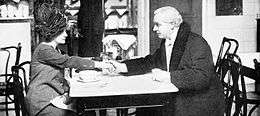The Governor's Lady
The Governor's Lady is a 1912 play written by Alice Bradley, directed by David Belasco and produced by Belasco and his son-in-law David Elliott. It is known for its unconventional set.
Production

After previews in Philadelphia[1] and Washington[2] The Governor's Lady opened at Belasco's Republic Theatre in New York on September 10, 1912.[3] Emma Dunn and Emmett Corrigan starred as Mary and Dan Slade, Gladys Hanson played Katherine Strickland and Milton Sills played Robert Hayes.[4][5] The three-act contemporary domestic drama dealt with topics of rising social status and the then-little-discussed topic of divorce.[6] The reasonably well-reviewed[7] and moderately commercially successful play ran 135 performances.[3] It is primarily known as an example of Belasco's theatrical naturalism, because he recreated a Childs Restaurant on stage using materials and food from the actual restaurant chain rather than conventional representative stage scenery.[8][9]
References
- "'Governor's Lady' Shown", New York Times, May 2, 1912.
- "Early Fall Brings Many New Plays", New York Times, Jun. 17, 1912.
- Mantle and Sherwood, The Best Plays of 1909-1919, p. 475.
- White, "The Stage", p. 827
- "The Governor's Lady", Internet Broadway Database.
- "The New Plays", p. 100.
- "Seeing This Play Seems Like Spying: Such a Sense of Intimacy Is Conveyed", New York Times, Sep. 11, 1912.
- Dodge, Staging a Popular Restaurant, p. 104.
- Essin, Designing American Modernity, pp. 32-33.
Bibliography
- Dodge, Wendell Phillips, "Staging a Popular Restaurant", The Theatre Magazine, v.XVI n.140, October 1912, pp. 104 and x-xi.
- "Early Fall Brings Many New Plays...There's 'The Governor's Lady' and Many Others", New York Times, Jun. 17, 1912, p. 9.
- Essin, Christin, "Designing American Modernity: David Belasco's The Governor's Lady and Robert Edmond Jones's The Man Who Married a Dumb Wife", Theatre History Studies, v.29, Tuscaloosa: University of Alabama Press, 2009, pp. 32–51. ISBN 0-8173-5554-5
- "'Governor's Lady' Shown: Belasco Produces Play of Man and Wife's Rise from Poverty to Riches, The New York Times, May 2, 1912, p. 11.
- Mantle, Burns and Garrison P. Sherwood, eds., The Best Plays of 1909-1919, Philadelphia: The Blakiston Company, 1947.
- "The New Plays", The Theatre Magazine, v.XVI n.140, October 1912, pp. 100.
- "Seeing This Play Seems Like Spying: Such a Sense of Intimacy Is Conveyed in 'The Governor's Lady,' at the Republic, Really Remarkable Acting, Emmett Corrigan and Emma Dunn Give Amazingly Fine Portrayals in a Realistic Belasco Production," (Play Review) New York Times, Sep. 11, 1912, p. 11.
- White, Jr., Matthew, "The Stage", Munsey's Magazine, April 1912, v.47 n.1, p 827.
External links
| Wikimedia Commons has media related to The Governor's Lady. |